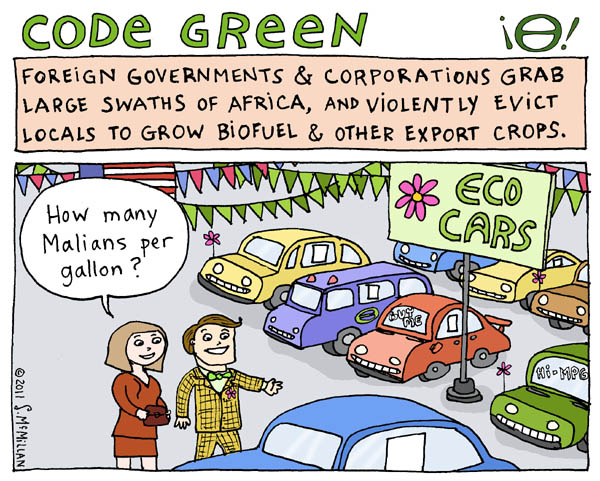
by Deep Green Resistance News Service | Mar 21, 2013 | Biodiversity & Habitat Destruction, Climate Change, NEWS
By Root Force
A series of recently released studies make it clear that wind power is not going to save us—not from global warming, not from high extinction rates, and not from the system of high-energy-consumption industrial exploitation that is killing the planet.
Let’s start with the most damning findings: even the most large-scale shift to wind power cannot slow greenhouse gas emissions enough to have any positive effect on the climate, although it may manage to make things worse. Why?
A study published in Nature Climate Change in September found that although hypothetically there is enough power in the earth’s winds to sustain current levels of energy consumption, in practice you could never harvest enough energy from wind to affect the climate:
Turbines create drag, or resistance, which removes momentum from the winds and tends to slow them. As the number of wind turbines increases, the amount of energy that is generated increases. But at some point, the winds would be slowed so much that adding more turbines will not generate more electricity. …
[T]he study found that the climate effects of extracting wind energy at the level of current global demand would be small, as long as the turbines were spread out and not clustered in just a few regions. At the level of global energy demand, wind turbines might affect surface temperatures by about 0.2 degrees Fahrenheit and affect precipitation by about 1 percent. Overall, the environmental impacts would not be substantial. (emphasis added)
Another study, published in Nature last month, found that wind farms being constructed in Scotland actually lead to a net increase in carbon dioxide emissions:
Wind farms are typically built on upland sites, where peat soil is common. In Scotland alone, two thirds of all planned onshore wind development is on peatland. England and Wales also have large numbers of current or proposed peatland wind farms.
But peat is also a massive store of carbon, described as Europe’s equivalent of the tropical rainforest. Peat bogs contain and absorb carbon in the same way as trees and plants — but in much higher quantities.
British peatland stores at least 3.2 billion tons of carbon, making it by far the country’s most important carbon sink and among the most important in the world.
Wind farms, and the miles of new roads and tracks needed to service them, damage or destroy the peat and cause significant loss of carbon to the atmosphere, where it contributes to climate change. …
Richard Lindsay of the University of East London, said … “The world’s peatlands have four times the amount of carbon than all the world’s rainforests. But they are a Cinderella habitat, completely invisible to decision- makers.”
Finally, a study published last month in the journal Environmental Research Letters conducted a further analysis on the effects of wind turbine drag:
Each wind turbine creates behind it a “wind shadow” in which the air has been slowed down by drag on the turbine’s blades. The ideal wind farm strikes a balance, packing as many turbines onto the land as possible, while also spacing them enough to reduce the impact of these wind shadows. But as wind farms grow larger, they start to interact, and the regional-scale wind patterns matter more.
Keith’s research has shown that the generating capacity of very large wind power installations (larger than 100 square kilometers) may peak at between 0.5 and 1 watts per square meter. Previous estimates, which ignored the turbines’ slowing effect on the wind, had put that figure at between 2 and 7 watts per square meter.
In short, we may not have access to as much wind power as scientists thought.
“If wind power’s going to make a contribution to global energy requirements that’s serious, 10 or 20 percent or more, then it really has to contribute on the scale of terawatts in the next half-century or less,” says Keith.
If we were to cover the entire Earth with wind farms, he notes, “the system could potentially generate enormous amounts of power, well in excess of 100 terawatts, but at that point my guess, based on our climate modeling, is that the effect of that on global winds, and therefore on climate, would be severe — perhaps bigger than the impact of doubling CO2.” (emphasis added)
As if that weren’t enough, another study has just concluded that large wind turbines constructed offshore may snap like matches when hit by medium-size waves:
“If we do not take ringing into consideration, offshore wind turbine parks can lead to financial ruin,” warns John Grue to the research magazine Apollon at University of Oslo. …
Ringing does not just harm wind turbines. Ringing has already been a great problem for the oil industry. The designers of the YME platform did not take ringing into account, and lost NOK 12 billion.
“It is possible to build your way out of the ringing problem by strengthening the oil rigs. However, it is not financially profitable to do the same with wind turbines,” says John Grue.
And finally, let’s not forget what environmentalists have been warning about for decades: wind turbines murder birds.
ReWire has learned that the North Sky River Wind project, which attracted fierce opposition from environmental groups concerned about potential threat to eagles and California condors, was the site of a golden eagle death in January. …
The eagle kill apparently occurred on January 29, just a month after North Sky River started generating power.
So what’s the solution? Certainly not wind, solar, or any other industrial magic bullet. The solution is to dramatically scale back consumption and shift to local-based economies not dependent upon stealing resources from distant people and lands.
The solution is to demolish the global economic system.
Get started!
Photo by Casey Horner on Unsplash
by Deep Green Resistance News Service | Feb 24, 2013 | Biodiversity & Habitat Destruction, Climate Change
By Andrew Gilligan / The Telegraph
Thousands of Britain’s wind turbines will create more greenhouse gases than they save, according to potentially devastating scientific research to be published later this year.
The finding, which threatens the entire rationale of the onshore wind farm industry, will be made by Scottish government-funded researchers who devised the standard method used by developers to calculate “carbon payback time” for wind farms on peat soils.
Wind farms are typically built on upland sites, where peat soil is common. In Scotland alone, two thirds of all planned onshore wind development is on peatland. England and Wales also have large numbers of current or proposed peatland wind farms.
But peat is also a massive store of carbon, described as Europe’s equivalent of the tropical rainforest. Peat bogs contain and absorb carbon in the same way as trees and plants — but in much higher quantities.
British peatland stores at least 3.2 billion tons of carbon, making it by far the country’s most important carbon sink and among the most important in the world.
Wind farms, and the miles of new roads and tracks needed to service them, damage or destroy the peat and cause significant loss of carbon to the atmosphere, where it contributes to climate change.
Writing in the scientific journal Nature, the scientists, Dr Jo Smith, Dr Dali Nayak and Prof Pete Smith, of Aberdeen University, say: “We contend that wind farms on peatlands will probably not reduce emissions …we suggest that the construction of wind farms on non-degraded peats should always be avoided.”
Dr Nayak told The Telegraph: “Our full paper is not yet published, but we should definitely be worried about this. If the peatland is already degraded, there is no problem. But if it is in good condition, we should avoid it.”
Another peat scientist, Richard Lindsay of the University of East London, said: “If we are concerned about CO2, we shouldn’t be worrying first about the rainforests, we should be worrying about peatlands.
“The world’s peatlands have four times the amount of carbon than all the world’s rainforests. But they are a Cinderella habitat, completely invisible to decision- makers.”
One typical large peat site just approved in southern Scotland, the Kilgallioch wind farm, includes 43 miles of roads and tracks. Peat only retains its carbon if it is moist, but the roads and tracks block the passage of the water.
The wind industry insists that it increasingly builds “floating roads,” where rock is piled on a textile surface without disturbing the peat underneath.
But Mr Lindsay said: “Peat has less solids in it than milk. The roads inevitably sink, that then causes huge areas of peatland to dry out and the carbon is released.”
Mr Lindsay said that more than half of all British onshore wind development, current and planned, is on peat soils.
In 2011 the Scottish government’s nature protection body, Scottish Natural Heritage, said 67 per cent of planned onshore wind development in Scotland would be on peatland.
Read more from The Telegraph: http://www.telegraph.co.uk/earth/energy/windpower/9889882/Wind-farms-will-create-more-carbon-dioxide-say-scientists.html
by Deep Green Resistance News Service | Feb 1, 2013 | Agriculture, Climate Change
By Bangor University
Growing oil palm to make ‘green’ biofuels in the tropics could be accelerating the effects of climate change, say scientists.
Researchers from Bangor University found the creation of oil palm plantations are releasing prehistoric sources of carbon dioxide back into the atmosphere.
The findings throw into doubt hopes that biofuels grown in the tropics could help cut greenhouse gas emissions.
Working as part of an international team, the north Wales scientists looked at how the deforestation of peat-swamps in Malaysia, to make way for oil palm trees, is releasing carbon which has been locked away for thousands of years.
It is feared this carbon will be attacked by microbes and produce the greenhouse gas, carbon dioxide. The Bangor researchers say the ancient carbon comes from deep in the soil, which as the effects of deforestation take hold, breaks down and dissolves into the nearby watercourses.
When describing their work which appears in Nature, Prof Chris Freeman commented: “We first noticed that the ditches draining areas converted to palm oil plantations were loaded with unusually high levels of dissolved carbon back in 1995, but it was not until my researcher Dr Tim Jones took samples to measure the age of that carbon that we realised we were onto something important”. Dr Jones added “We were amazed to discover that the samples from Malaysian oil palm plantations contained the oldest soil-derived dissolved organic carbon ever recorded.”
The Bangor University researchers measured the water leaching from channels in palm oil plantations in the Malaysian peninsular which were originally Peatland Swamp Forest. There are approximately 28,000 km2 of industrial plantations in peninsular Malaysia, Sumatra and Borneo with even more planned, making them a major contributor to peatswamp deforestation in the region. Prof Freeman commented; “Our results are yet another reminder that when we disturb intact peatswamps and convert them to industrial biofuel plantations, we risk adding to the very problem that we are trying to solve”
Prof Freeman added: “We have known for some time that in South East Asia, oil palm plantations were a major threat to biodiversity, including the habitat for orang-utans, and that the drainage could release huge amounts of carbon dioxide during the fires seen there in recent years. But this discovery of a “hidden” new source of problems in the waters draining these peatlands is a reminder that these fragile ecosystems really are in need of conservation.”
Read more from Bangor University: http://www.bangor.ac.uk/news/full.php.en?nid=12106&tnid=12106

by Deep Green Resistance News Service | Oct 12, 2012 | Climate Change
By Inderscience Publishers
Biofuels will serve the interests of large industrial groups rather than helping to cut carbon emissions and ward off climate change, according to research to be published in the International Journal of Environment and Health this month.
Simone Vieri of the University “La Sapienza” of Rome, Italy, explains that, in its policies to combat climate change, the European Union has planned to increase to 10% the share of fuel derived from biofuels on the market by 2020. It has focused attention on first-generation biofuels, made from the conversion of plant material which can be grown specifically for fuel production, such as corn, soy, sugarcane or palm oil. It has given only a secondary role to second-generation biofuels, made from agricultural and woody crop biomass, including waste and by-products.
Vieri suggests that, “In 2020 the EU won’t be able to keep to its 10% biofuels goal using only European agricultural production, but will have to continue importing the greatest part of raw materials, or biofuels.”
In this frame, Vieri explains that, “The EU’s decision to focus on the first-generation biofuels, raises many doubts.” In particular, the approach seems to favour several issues. For instance, it favours production systems that are in competition with traditional agriculture for use of resources and production factors, he says. Additionally, to encourage agro-industrials models, such as those on which the production of first generation biofuels is based, might compromise the possibility of developing models based on multifunctional agriculture and, then, on the production of energy from agriculture waste and by-products rather than from dedicated products.
The adoption of first-generation biofuels sometimes leads to exploitation of human and environmental resources of poorer countries, adds Vieri, as they are commonly the source of many of the agricultural raw materials used for production of biofuels. Moreover, agricultural production processes that change land use can lead to zero net benefit in terms of emissions reduction.
Other problems that arise when reliance is placed on first-generation biofuels lie with the economics. Financial market speculation strengthens the link between the price of oil and the price of the main agricultural raw materials, Vieri says. Furthermore, an increase, or instability of agricultural products’ prices, weighs heavily on poorer nations and their food security.
In this context “the choice to promote first generation biofuels is an example of how politics places the protection of the interests and profit strategies of a restricted number of subjects before the costs and benefits to be had on a wider scale,” adds Vieri.
Vieri adds that the “green economy” model might break new ground if it were to prove able to facilitate reduced emissions and allow economic growth and development with direct benefit to society itself rather than the profits of multinationals.

by Deep Green Resistance News Service | Oct 9, 2012 | Biodiversity & Habitat Destruction, Colonialism & Conquest, Indigenous Autonomy, Obstruction & Occupation
By Jeremy Hance / Mongabay
Construction on Brazil’s megadam, Belo Monte, has been halted again as around 150 demonstrators, most of them from nearby indigenous tribes, have occupied the main construction site at Pimental. Over a hundred indigenous people joined local fishermen who had been protesting the dam for 24 days straight. Indigenous people and local fishermen say the dam will devastate the Xingu River, upending their way of life.
“The renewed occupation of the project’s earthen cofferdams paralyzed construction works, while indigenous protestors seized the keys of trucks and tractors forcing workers to leave the strategic Pimental work camp on foot,” reads a press release from the NGO Amazon Watch. Around 900 workers were sent home.
This is the second occupation attempt in less than six months. Over the summer some 300 indigenous people sustained an occupation of the dam for 21 days, before breaking it off though little headway was made in talks with consortium building the dam, Norte Energia.
The Belo Monte dam, which would be the world’s third largest, has been plagued by controversy from its origin decades ago; the battle for the dam has been fought both in Brazil’s courts and on the international stage. If built, the dam will flood an estimated 40,000 hectares of present rainforest and could push some fish species to extinction. In addition, 16,000 people will be displaced according to the government, though some NGOs say the number is more likely double that.
Despite the impacts, the dam has been strongly supported by Brazilian President Dilma Rousseff, and every legal injunction against the dam has been overturned. Norte Energia has filed with a local court for repossession of the construction sties.
Indigenous groups say the construction of the dam is already imperiling their way of life, as the Xingu river becomes more difficult to navigate. They have also said they have no intention of leaving until Norte Energia meets their demands.
“We are witnessing the devastation of this land. The island of Pimental was completely destroyed, with a sole tree left standing, and the water is putrid. It is very shocking,” an protestor told Amazon Watch.
Dams are often described as ‘green’ energy source, however in the tropics they actually release significant methane emissions due to rotting vegetation. Although it has a shorter life than carbon, methane is a far more potent greenhouse gas.
From Mongabay: “Indigenous groups re-occupy Belo Monte dam in the Amazon“



